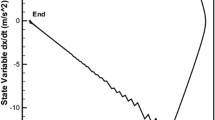Abstract
This paper proposes a new control framework for a cooperative robotic system which consists of two manipulators to grasp and handle an object with known geometry. Based on passive decomposition approach, the dynamics of the cooperative system are decomposed into the shape and locked systems, considering uncertainty in the dynamics of the robots. Two higher-order sliding mode controllers are designed for them and are tuned by genetic algorithm in the form of an optimization problem. Using the passivity property of passive decomposition approach, the proposed new higher-order sliding mode controllers ensure passivity of the closed loop system. Stability and convergence of the tracking errors are proved by defining a Lyapunov function and using Barbalat’s lemma. Eventually, the comparative simulation results confirmed that the proposed control scheme works well and as expected, works better than the classical sliding mode controllers.








Similar content being viewed by others
References
Wen JT, Kreutz-Delgado K (1992) Motion and force control of multiple robotic manipulators. Automatica 28(4):729–743
Tinós R, Terra MH, Ishihara JY (2006) Motion and force control of cooperative robotic manipulators with passive joints. IEEE Trans Control Syst Technol 14(4):725–734
Mohajerpoor R, Rezaei M, Talebi A, Noorhosseini M, Monfaredi R (2012) A robust adaptive hybrid force/position control scheme of two planar manipulators handling an unknown object interacting with an environment. Proc Inst Mech Eng Part I J Syst Control Eng 226(4):509–522
Schneider SA, Cannon RH (1992) Object impedance control for cooperative manipulation: theory and experimental results. IEEE Trans Robot Autom 8(3):383–394
Lee D, Spong MW (2005) Bilateral teleoperation of multiple cooperative robots over delayed communication networks: theory. In: Proceedings of the 2005 IEEE international conference on robotics and automation, ICRA 2005. IEEE, pp 360–365
Kawasaki H, Ueki S, Ito S (2006) Decentralized adaptive coordinated control of multiple robot arms without using a force sensor. Automatica 42(3):481–488
Gudino-Lau J, Arteaga MA (2005) Dynamic model and simulation of cooperative robots: a case study. Robotica 23(5):615–624
Gudiño-Lau J, Arteaga MA, Munoz LA, Parra-Vega V (2004) On the control of cooperative robots without velocity measurements. IEEE Trans Control Syst Technol 12(4):600–608
Tsuji T, Jazidie A, Kaneko M (1997) Distributed trajectory generation for cooperative multi-arm robots via virtual force interactions. IEEE Trans Syst Man Cybern Part B (Cybernetics) 27(5):862–867
Liu Y-H, Arimoto S (1998) Decentralized adaptive and nonadaptive position/force controllers for redundant manipulators in cooperations. Int J Robot Res 17(3):232–247
Sirouspour S (2005) Modeling and control of cooperative teleoperation systems. IEEE Trans Robot 21(6):1220–1225
Li Z, Su C-Y (2013) Neural-adaptive control of single-master-multiple-slaves teleoperation for coordinated multiple mobile manipulators with time-varying communication delays and input uncertainties. IEEE Trans Neural Netw Learn Syst 24(9):1400–1413
Lee D, Martinez-Palafox O, Spong MW (2005) Bilateral teleoperation of multiple cooperative robots over delayed communication networks: application. In: Proceedings of the 2005 IEEE international conference on robotics and automation, ICRA 2005. IEEE, p 366371
Monfaredi R, Rezaei SM, Talebi HA (2011) A cooperative robotic system for handling a geometrically unknown object for non-rigid contact without force sensors. In: 2011 IEEE international conference on robotics and biomimetics (ROBIO), IEEE, pp 240–245
Bistooni M, Monfaredi R (2014) Cooperative robotic system contorl scheme for 6DOF spatial handling of a geometrically unknown object. Trans Control Mech Syst 3(11):93–99
Spong MW, Hutchinson S, Vidyasagar M et al (2006) Robot modeling and control, vol 3. Wiley, New York
Lee D (2004) Passive decomposition and control of interactive mechanical systems under motion coordination requirements. Ph.D. Dissertation
Bartoszewicz A, Patton RJ (2007) Sliding mode control. Int J Adapt Control Sig Process 21(8–9):635–637
Bartolini G, Ferrara A, Usai E, Utkin VI (2000) On multi-input chattering-free second-order sliding mode control. IEEE Trans Autom Control 45(9):1711–1717
Yuhua X, Chongwei Z, Wei B, Lin T (2009) Dynamic sliding mode controller based on particle swarm optimization for mobile robot’s path following. In: International forum on information technology and applications. IFITA’09. vol 1, IEEE, pp 257–260
Haupt R L, Haupt S E, Haupt S E (1998) Practical genetic algorithms, vol 2. Wiley, New York
Bayati M, Salmani A, Abedi M, Gharepetian GB (2015) A novel technique for optimization of power systems implemented in simulink (case study: Multi-area frequency control). In: 2015 international conference on power, instrumentation, control and computing (PICC), IEEE, pp 1–6
Author information
Authors and Affiliations
Corresponding author
Rights and permissions
About this article
Cite this article
Farahmandrad, M., Ganjefar, S., Talebi, H.A. et al. Design of higher-order sliding mode controller based on genetic algorithm for a cooperative robotic system. Int. J. Dynam. Control 8, 269–277 (2020). https://doi.org/10.1007/s40435-019-00516-x
Received:
Revised:
Accepted:
Published:
Issue Date:
DOI: https://doi.org/10.1007/s40435-019-00516-x




